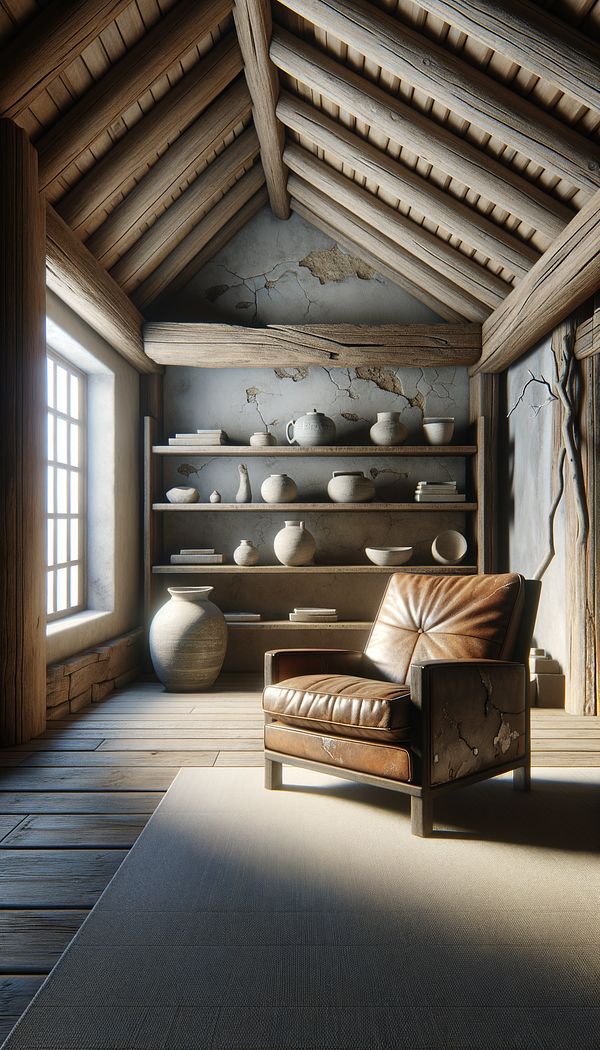What is Wabi-Sabi?
Wabi-sabi is a Japanese philosophy that finds beauty in imperfection and transience.
Description
Wabi-sabi is a traditional Japanese aesthetic and world view that emphasizes the beauty inherent in the impermanent, the imperfect, and the incomplete. This philosophy, deeply rooted in Zen Buddhism, encourages us to appreciate the natural cycle of growth and decay. It finds value and beauty in the modest and humble, the irregular, and the intimate. In interior design, wabi-sabi inspires spaces that are simple, uncluttered, and characterized by the use of natural materials, textures, and a neutral color palette. This approach to design not only seeks to create a peaceful and contemplative environment but also fosters a deep connection with the natural world and the authentic essence of life. Wabi-sabi is about embracing the flaws and blemishes that come with time, acknowledging them as integral parts of an object's history and aesthetic value. It teaches us that beauty can be found in the weathered, the worn, and the transient, encouraging an appreciation for the 'perfectly imperfect.' Through wabi-sabi, designers and homeowners are motivated to make thoughtful choices that reflect a mindful, authentic, and sustainable approach to living.
Usage
In the context of interior design, wabi-sabi can manifest in various ways. This could include incorporating well-loved or handmade pieces with visible marks of wear, choosing natural materials like wood with visible grains or stone with unique imperfections, or designing spaces that foreground simplicity and authenticity. Furniture and decor inspired by wabi-sabi carry a sense of history and uniqueness, and the overall design aesthetic promotes a calm, settled atmosphere where the emphasis is on comfort and genuine living rather than perfection.
FAQs
-
How does wabi-sabi differ from minimalism?
While both wabi-sabi and minimalism appreciate simplicity in design, they diverge in their approach and underlying philosophy. Minimalism focuses on decluttering and the idea of 'less is more,' prioritizing functionality and clean lines. Wabi-sabi, on the other hand, values the inherent beauty of natural imperfections and the storied histories of objects. It seeks to create spaces that feel lived-in and authentic, embracing wear and uniqueness as elements of beauty.
-
Can wabi-sabi be applied in modern homes?
Absolutely. Wabi-sabi is a timeless philosophy that can complement any living space, modern or traditional. Incorporating wabi-sabi in modern homes could involve choosing furnishings and decorative items that showcase natural imperfections, allowing materials to age gracefully, and designing spaces that feel personal, comfortable, and true to one's experience of life. Its emphasis on authenticity and natural beauty can provide a tranquil counterpart to the clean lines of modern design.
-
Is wabi-sabi only applicable to aesthetics?
Though wabi-sabi has a significant aesthetic component, it is more deeply a life philosophy that advocates for a mindful and authentic approach to living. It encourages recognizing and accepting the impermanence and flaws in our surroundings and ourselves. In interior design, this translates to spaces that reflect genuine living, but the principles of wabi-sabi can similarly inspire personal growth, mindfulness, and an appreciation for the transient moments of life.
Practical Application
To incorporate wabi-sabi into your home, start by embracing the beauty of natural materials and accepting the charm of imperfections. Opt for items that tell a story, whether through their craftsmanship or the marks of use they bear. Create spaces that feel intimate and calming, prioritizing comfort over perfection. By adopting a wabi-sabi approach, you can design a living environment that reflects not only a sense of aesthetic beauty but also a richer, more authentic way of living.
-
Design Styles478 articles
-
Decorative Techniques322 articles
-
Decorative Objects240 articles
-
Materials & Textiles360 articles
-
Sustainability & Eco-Friendly Design69 articles
-
Floor PlanA floor plan is a scale drawing that presents the layout of a space from above.
-
Handkerchief TableA handkerchief table is a type of drop-leaf table where the leaves are supported by brackets that swing out, resembling a handkerchief partially unfolded.
-
Reclaimed WoodReclaimed wood is recycled wood that has been repurposed for new uses.
-
Square LegA square leg is a type of furniture leg that has a square or rectangular shape.
-
BandingBanding refers to the decorative detail created by applying strips of material to the edges or borders of furniture, textiles, or architectural features.
